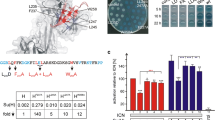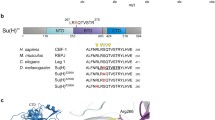Abstract
The Notch signaling pathway is highly conserved in all animal metazoa: upon Notch receptor activation, transcription of Notch target genes is turned on by an activator complex that centers on the transcription factor CSL. In the absence of signal, CSL assembles transcriptional repression complexes that display remarkable evolutionary diversity. The major antagonist of Notch signaling in insects named Hairless was originally identified in Drosophila melanogaster. It binds to the Drosophila CSL homologue Suppressor of Hairless [Su(H)] and recruits the two general co-repressors, Groucho and C-terminal binding protein. Whereas the majority of Notch signaling components is conserved between insects and vertebrates, Hairless is found only in insects. Here, we present the analysis of the Hairless gene from Daphnia pulex and, hence, for the first time from a crustacean. Daphnia and Drosophila Hairless protein sequences are highly diverged. Known functional domains, however, the Su(H), Groucho and the C-terminal binding protein interactions domains, are well conserved. Moreover, direct binding of the Daphnia Hairless protein and the respective Drosophila interaction partners was detected, demonstrating the conservation at the molecular level. In addition, interaction between Daphnia Hairless and Drosophila Su(H) was demonstrated in vivo, as co-overexpression of the respective genes during Drosophila development resulted in the expected downregulation of Notch activity in the fly. Structural models show that the Hairless-Su(H) repressor complexes from Daphnia and Drosophila are almost indistinguishable from one another. Amino acid residues in direct contact within the Hairless-Su(H) complex are at absolutely identical positions in the two homologues.











Similar content being viewed by others
Notes
Flybase (http://flybase.org/reports/FBgn0001169.html) refers to five H orthologues in the centipede Strigamia maritima. Only one of the deposited sequences, however, shares weak homology with the H gene maybe representing a true H homologue. We have notified flybase of our observations.
References
Bang AG, Hartenstein V, Posakony JW (1991) Hairless is required for the development of adult sensory organ precursor cells in Drosophila. Development 111:89–104
Bang AG, Posakony JW (1992) The Drosophila gene Hairless encodes a novel basic protein that controls alternative cell fates in adult sensory organ development. Genes Dev 6:1752–1769
Barolo S, Stone T, Bang AG, Posakony JW (2002) Default repression and Notch signaling: Hairless acts as an adaptor to recruit the corepressors Groucho and dCtBP to Suppressor of Hairless. Genes Dev 16:1964–1976
Bischof J, Maeda RK, Hediger M, Karch F, Basler K (2007) An optimized transgenesis system for Drosophila using germ-line-specific phiC31 integrases. Proc Natl Acad Sci U S A 104:3312–3317
Borggrefe T, Oswald F (2009) The Notch signaling pathway: transcriptional regulation at Notch target genes. Cell Mol Life Sci 66:1631–1646
Brand AH, Perrimon N (1993) Targeted gene expression as a means of altering cell fates and generating dominant phenotypes. Development 118:401–415
Bray SJ (2016) Notch signalling in context. Nat Rev Mol Cell Biol 17:722–735
Buscarlet M, Stifani S (2007) The ‘Marx’ of Groucho on development and disease. Trends Cell Biol 17:353–361
Chien CT, Hsiao CD, Jan LY, Jan YN (1996) Neuronal type information encoded in the basic-helix–loop–helix domain of proneural genes. Proc Natl Acad Sci U S A 93(23):13239–13244
Colbourne JK, Pfrender ME, Gilbert D, Thomas WK, Tucker A, Oakley TH, Tokishita S, Aerts A, Arnold GJ, Basu MK et al (2011) The ecoresponsive genome of Daphnia pulex. Science 33:555–561
Collins KJ, Yuan Z, Kovall RA (2014) Structure and function of the CSL-KyoT2 corepressor complex: a negative regulator of Notch signaling. Structure 22:70–81
Contreras-Cornejo H, Saucedo-Correa G, Oviedo-Boyso J, Valdez-Alarcón JJ, Baizabal-Aguirre VM, Cajero-Juárz M, Bravo-Patiño A (2016) The CSL proteins, versatile transcription factors and context dependent corepressors of the Notch signaling pathway. Cell Div 11:12
Gyuris J, Golemis E, Chertkov H, Brent R (1993) Cdi1, a human G1 and S phase protein phosphatase that associates with cdk2. Cell 75:791–803
Hartenstein AY, Rugendorf A, Tepass U, Hartenstein V (1992) The function of the neurogenic genes during epithelial development in the Drosophila embryo. Development 116:1203–1220
Hartenstein V, Stollewerk A (2015) The evolution of early neurogenesis. Dev Cell 32:390–407
Honeybee Genome Sequencing Consortium (2006) Insights into social insects from the genome of the honeybee Apis mellifera. Nature 443:931–949
Hori K, Sen A, Artavanis-Tsakonas S (2013) Notch signaling in glance. J Cell Sci 126:2135–2140
Kawaichi M, Oka C, Shibayama S, Koromilas AE, Matsunami N, Hamaguchi Y, Honjo T (1992) Genomic organization of Mouse J kappa recombination signal binding protein (RBP-J kappa) gene. J Biol Chem 267:4016–4022
Kim J, Sebring A, Esch JJ, Kraus ME, Vorwerk K, Magee J, Carroll SB (1996) Integration of positional signals and regulation of wing formation and identity by Drosophila vestigial gene. Nature 382:133–138
Klann M, Stollewerk A (2017) Evolutionary variation in neural gene expression in the develo** sense organs of the crustacean Daphnia magna. Dev Biol 424:50–61
Kovall RA, Blacklow SC (2010) Mechanistic insights into Notch receptor signaling from structural and biochemical studies. Curr Top Dev Biol 92:31–71
Kurth P, Preiss A, Kovall RA, Maier D (2011) Molecular analysis of the Notch repressor-complex in Drosophila: characterization of potential Hairless binding sites on Suppressor of Hairless. PLoS One 6(11):e27986
Lunde K, Trimble JL, Guichard A, Guss KA, Nauber U, Bier E (2003) Activation of the knirps locus links patterning to morphogenesis of the second wing vein in Drosophila. Development 130:235–248
Maier D (2006) Hairless: the ignored antagonist of the Notch signalling pathway. Hereditas 143:212–221
Maier D, Stumm D, Kuhn K, Preiss A (1992) Hairless, a Drosophila gene involved in neural development, encodes a novel, serine rich protein. Mech Dev 38:143–156
Maier D, Marquart J, Thompson-Fontaine A, Beck I, Wurmbach E, Preiss A (1997) In vivo structure-function analysis of Drosophila Hairless. Mech Dev 67:97–106
Maier D, Nagel AC, Preiss A (2002) Two isoforms of the Notch antagonist Hairless are produced by differential translation initiation. Proc Natl Acad Sci U S A 99:15480–15485
Maier D, Chen AX, Preiss A, Ketelhut M (2008) The tiny Hairless protein from Apis mellifera: a potent antagonist of Notch signalling in Drosophila melanogaster. BMC Evol Biol 8:175
Maier D, Kurth P, Schulz A, Russell A, Yuan Z, Gruber K, Kovall RA, Preiss A (2011) Structural and functional analysis of the repressor complex in the Notch signaling pathway of Drosophila melanogaster. Mol Biol Cell 22:3242–3252
Maier D, Praxenthaler H, Schulz A, Preiss A (2013) Gain of function Notch phenotypes associated with ectopic expression of the Su(H) C-terminal domain illustrate separability of Notch and Hairless-mediated activities. PLoS One 8:e81578
Marquart J, Alexief-Damianof C, Preiss A, Maier D (1999) Rapid divergence in the course of Drosophila evolution reveals structural important domains of the Notch antagonist Hairless. Dev Genes Evol 209:155–164
Morel V, Lecourtois M, Massiani O, Maier D, Preiss A, Schweisguth F (2001) Transcriptional repression by Suppressor of Hairless involves the binding of a Hairless-dCtBP complex in Drosophila. Curr Biol 11:789–792
Müller D, Kugler SJ, Preiss A, Maier D, Nagel AC (2005) Genetic modifier screens on Hairless gain-of-function phenotypes reveal genes involved in cell differentiation and cell death. Genetics 171:1137–1152
Nagel AC, Maier D, Preiss A (2000) Su(H) independent activity of Hairless during mechano-senory organ formation in Drosophila. Mech Dev 94:3–12
Nagel AC, Krejci A, Tenin G, Bravo-Patiño A, Bray S, Maier D, Preiss A (2005) Hairless-mediated repression of notch target genes requires the combined activity of Groucho and CtBP corepressors. Mol Cell Biol 25:10433–10441
Nagel AC, Preiss A (2011) Fine tuning of Notch signaling by differential co-repressor recruitment during eye development of Drosophila. Hereditas 148:77–84
Neumann CJ, Cohen SM (1996) A hierarchy of cross-regulation involving Notch, wingless, vestigial and cut organizes the dorsal/ventral axis of the Drosophila wing. Development 122:347–3485
Oswald F, Kostezka U, Astrahantseff K, Bourteele S, Dillinger K, Zechner U, Ludwig L, Wilda M, Hameister H, Knöchel W, Liptay S, Schmid RM (2002) SHARP is a novel component of the Notch/RBP-Jkappa signalling pathway. EMBO J 21:5417–5426
Oswald F, Winkler M, Cao Y, Astrahantseff K, Bourteele S, Knöchel W, Borggrefe T (2005) RBP-Jkappa/SHARP recruits CtIP/CtBP corepressors to silence Notch target genes. Mol Cell Biol 25:10379–10390
Praxenthaler H, Smylla TK, Nagel AC, Preiss A, Maier D (2015) Generation of new Hairless alleles by genomic engineering at the Hairless locus in Drosophila melanogaster. PLoS One 10(10):e0140007
Preiss A, Hartley DA, Artavanis-Tsakonas S (1988) The molecular genetics of Enhancer of split, a gene required for embryonic neural development in Drosophila. EMBO J 7:3917–3927
Protzer CE, Wech I, Nagel AC (2008) Hairless induces cell death by downregulation of EGFR signalling activity. J Cell Sci 121:3167–3176
Schlatter R, Maier D (2005) The Enhancer of split and Achaete-Scute complexes of Drosophilids derived from simple ur-complexes preserved in mosquito and honeybee. BMC Evol Biol 5:67
Schweisguth F (2015) Asymmetric cell division in the Drosophila bristle lineage: from the polarization of sensory organ precursor cells to Notch-mediated binary fate decision. WIREs Dev Biol 4:299–309
Simpson P (1990) Lateral inhibition and the development of the sensory bristles of the adult peripheral nervous system of Drosophila. Development 109:509–519
Smylla TK, Preiss A, Maier D (2016) In vivo analysis of internal ribosome entry at the locus by genome engineering in Drosophila. Sci Rep. https://doi.org/10.1038/srep34881
Tabaja N, Yuan Z, Oswald F, Kovall RA (2017) Structure-function analysis of RBPJ-interacting and tubulin-associated (RITA) reveals regions critical for repression of Notch target genes. J Biol Chem 292(25):10549–10563
Turner J, Crossley M (2001) The CtBP family: enigmatic and enzymatic transcriptional co-repressors. BioEssays 23:683–690
Ungerer P, Eriksson BJ, Stollewerk A (2011) Neurogenesis in the water flea Daphnia magna (Crustacea, Branchiopoda) suggests different mechanisms of neuroblast formation in insects and crustaceans. Dev Biol 357:42–52
Yuan Z, Praxenthaler H, Tabaja N, Torella R, Preiss A, Maier D, Kovall RA (2016) Structure and function of the Su(H)-Hairless repressor complex, the major antagonist of Notch signalling in Drosophila melanogaster. PLoS Biol 14(7):e1002509
Zimmermann M, Kugler SJ, Schulz A, Nagel AC (2015) Loss of putzig activity results in apoptosis during wing imaginal development in Drosophila. PLoS One 10(4):e0124562
Acknowledgments
We greatly acknowledge U. Gigengack, H. Mastel, S. Mohaved, and H. Reichle for the technical assistance and L. Fedoseeva for the help during a Master module. We thank the DSHB for the antisera. We are grateful to J.K. Colbourne and D. Gilbert for sharing unpublished data and R.O. Schill for classifying the European Daphnia pulex species. We thank A.C. Nagel for carefully reading the manuscript. This work was supported by Deutsche Forschungsgemeinschaft (DFG) grants MA1328/10 and MA1328/11-1 to DM.
Funding
This study was funded by the German Research Foundation DFG to DM (MA1328/10 and MA1328/11-1).
Author information
Authors and Affiliations
Corresponding author
Ethics declarations
Conflict of interest
The authors declare that they have no conflict of interest.
Additional information
Communicated by Siegfried Roth
Electronic supplementary material
ESM 1
(PDF 1418 kb)
Rights and permissions
About this article
Cite this article
Zehender, A., Bayer, M., Bauer, M. et al. Conservation of the Notch antagonist Hairless in arthropods: functional analysis of the crustacean Daphnia pulex Hairless gene. Dev Genes Evol 227, 339–353 (2017). https://doi.org/10.1007/s00427-017-0593-4
Received:
Accepted:
Published:
Issue Date:
DOI: https://doi.org/10.1007/s00427-017-0593-4




